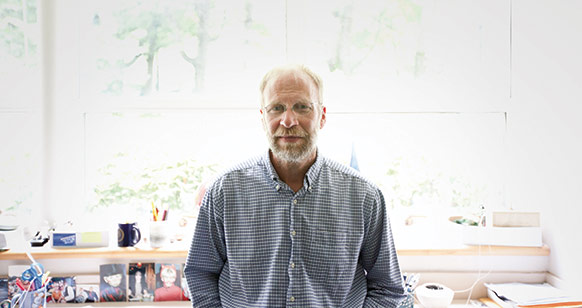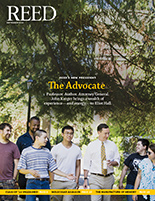
IRIS login | Reed College home Volume 91, No. 3: September 2012
The Darkness of Memory Lane (continued)

Our memories are not static, according to Professor Dan Reisberg [psychology 1986–]. They can be shaped, squeezed, and molded by subsequent experience. Photo by Darryl James
![]()
When Reisberg matriculated at Swarthmore in the 1970s, he was torn between philosophy and biology. “I learned,” he says, “that philosophy had a lot of interesting questions but very few answers. And biology—I loved the intellectual muscle of hard facts, but biology didn’t ask the questions I wanted to pose.”
Reisberg found a happy medium in psychology. He was especially enchanted with the study of cognition, a close cousin of epistemology, and he fell under the spell of an austere professor, Hans Wallach, a German émigré who pronounced himself (in a daunting one-on-one meeting with Reisberg, who was just 16) “one of the best experimentalists in the world.” Working in a predigital age, Wallach concocted ingenious lever-and-pulley gadgetry to conduct elegant studies of human perception. To test how the right ear and the left ear respectively process a given snippet of sound, he had his subjects wear a gutted welders’ helmet attached to a giant overhead wheel. Subjects dialed the wheel by turning their heads—and thereby directed their ears towards any one of a surrounding bank of stereo speakers.
“Hans never threw his gadgets out,” says Reisberg. “His lab was like a science museum.” Eventually, as a grad student at the University of Pennsylvania, Reisberg aimed to set up psychology experiments framed by Wallach’s “wonderful intuition and inventive research methods.” Mostly, he studied perception, writing papers with titles such as Looking Where You Listen: Visual Cues and Auditory Attention.
Later, as a young professor at the New School in New York, Reisberg met graduate student Friderike Heuer, now his wife. She was researching how the mind records memory amid traumatic emotional events, and Reisberg joined her to coauthor several papers. Today, Reisberg still does research, but he always pairs with students. On principle, he gives them first-author credit on papers. He has written several leading psychology textbooks on learning, perception, cognition, and memory.
Teaching is his true calling, however; for two decades, he’s focused on delivering the polysyllabic news contained in psych journals to Reed students, lawyers, jurors, and lay readers worldwide. He has given workshops on eyewitness IDs to police detectives and lawyers. He’s also brought police officers to Psych 350, Psychology and the Courts, to enlighten Reed students on the challenge of obtaining witness IDs. Currently on sabbatical, he is writing a handbook that lawyers can use in cases involving perception and memory.
Reisberg sometimes receives unusual phone calls. In 2003, the Dalai Lama, aiming to forge a link between Buddhist monks and Western scholars, held a two-day conference at MIT, “Investigating the Mind,” to which he invited Reisberg and several other psychologists. Reisberg remembers a somewhat surreal encounter. “We were instructed to act like this was just a normal conference,” he says, alluding to his colleagues, “but that’s hard to do when one of the people at the table is wearing a bright orange robe and is regarded by millions of people as a deity.”
His Holiness focused part of the discussion on mental visualization, and the monks reported being able to see elaborate images as they meditated—deities in flowing robes and mandalas of intricate detail. “When the image appears,” said one monk, “it’s like a fish jumping out of the water.”
Reisberg and his colleagues were dubious. “Their level of detail,” he says, “was not consistent with our understanding of the brain tissue that makes mental imagery possible.” He found himself in the awkward position of countering the Dalai Lama. As he remembers it, he and his colleagues pointed out that visualization has to be limited by the structure of the brain; they told His Holiness, “You can’t grow a third arm no matter how hard you try.”
The Dalai Lama was resolute, reminding the psychologists of recent findings on neuroplasticity, in which the brain shows a remarkable ability to reorganize itself in light of training and experience.
Reisberg’s work with the court system has been more pragmatic—and also quite varied. In one case, he considered an account of sexual abuse, disclosed for the first time by a small child during her bath. He testified on how the human mind might process auditory data amid the hard, echoey surfaces of a typical bathroom. In another case, he testified on how pretrial publicity might bias jurors against a murder suspect. In a different case, when jurors were presented with a scratchy audio recording of a sting operation, he explained why it was problematic that the recording had been transcribed: the transcriptionist had made interpretive guesses as to the content—and had thereby biased jurors’ ears. In a Fruitland, Idaho, murder case, he spoke about the suggestive tactics used by police investigators seeking to rein in the suspect.
Reisberg is hardly the first psychologist to raise questions about police investigations. Professor Gary Wells, at Iowa State University, launched the inquiry, arguably, in 1978, with a journal paper that categorized the factors compromising eyewitness ID. Wells described “estimator variables”—that is, variables that the criminal justice system can’t control: the quality of the witness’s vision, for instance—and also “system variables,” which cops and courts can control, such as the quality of photo lineups. In the years since, the research on eyewitness ID has become deeper and more nuanced. There are now many American psychologists who give expert testimony on eyewitness ID, and courts are increasingly open to learning from them. Indeed, last year in State v. Henderson the New Jersey Supreme Court recognized the “troubling lack of reliability in eyewitness identifications” and ruled that, before admitting such IDs, courts must consider context, by asking, for instance, if testimony was induced, or if the witness was drunk or emotionally stressed.
As Reisberg waits, hoping that the Oregon Supreme Court grants Samuel Lawson a retrial, he feels that the court would do well to emulate Henderson. But he stresses that the real work on improving eyewitness IDs must happen outside the courtroom. “We need to keep doing research on two tracks,” he says. “In the lab, and also in real life. We need to ask if what we learn in the laboratory—about perception, about memory—plays out in real-world criminal cases. In some cases, it hasn’t.” Laboratory studies have shown that, when confronted with a weapon, subjects have proven less able to process peripheral sensory data and make reliable IDs. In real life, though, people confronted by weapons have not proven weak at making IDs. “We don’t know why this is,” Reisberg says. “It’s a puzzle we need to untangle.”
Even more important than research, Reisberg says, is dialogue with police. “They have complicated jobs,” he says, “and so much to learn. They have to know how to use firearms, and how to drive at high speeds and write up reports. They get about 10 minutes’ training on how to run an ID, but they really want to do it the right way: they want to keep bad IDs out of court too.”
Once, after a trial involving a Portland gang shooting, Reisberg says he lingered in the hall with a police detective. “We had a conversation about what kind of investigation would make sense to him and me. His concern was that, in gang killings, witnesses are afraid to pick the guy out of a lineup. They think, ‘If I do that, someone will kill my momma.’ He was asking, ‘How do you coax someone into making an ID?’ My concern was they shouldn’t be coached.”
“We came to an understanding of one another,” Reisberg says, “There was progress, and that conversation has to continue. Because it’s a double tragedy when the bad guy goes free and an innocent man goes to prison.”
GO FURTHER
Learning and Memory by Daniel Reisberg and Barry Schwartz, 1991.
Auditory Imagery by Daniel Reisberg, editor, 1992.
Cognition: Exploring the Science of the Mind by Daniel Reisberg, 2012.
Psychology by H. Gleitman, D. Reisberg, and J. Gross, 2010
Memory and Emotion by Daniel Reisberg and P. Hertel, editors, 2004.
Handbook of Cognitive Psychology by Daniel Reisberg, 2012.
- Previous Page
- 1
- 2
- Next Page


LATEST COMMENTS
steve-jobs-1976 I knew Steve Jobs when he was on the second floor of Quincy. (Fall...
Utnapishtim - 2 weeks ago
Prof. Mason Drukman [political science 1964–70] This is gold, pure gold. God bless, Prof. Drukman.
puredog - 1 month ago
virginia-davis-1965 Such a good friend & compatriot in the day of Satyricon...
czarchasm - 4 months ago
John Peara Baba 1990 John died of a broken heart from losing his mom and then his...
kodachrome - 7 months ago
Carol Sawyer 1962 Who wrote this obit? I'm writing something about Carol Sawyer...
MsLaurie Pepper - 8 months ago
William W. Wissman MAT 1969 ...and THREE sisters. Sabra, the oldest, Mary, the middle, and...
riclf - 10 months ago